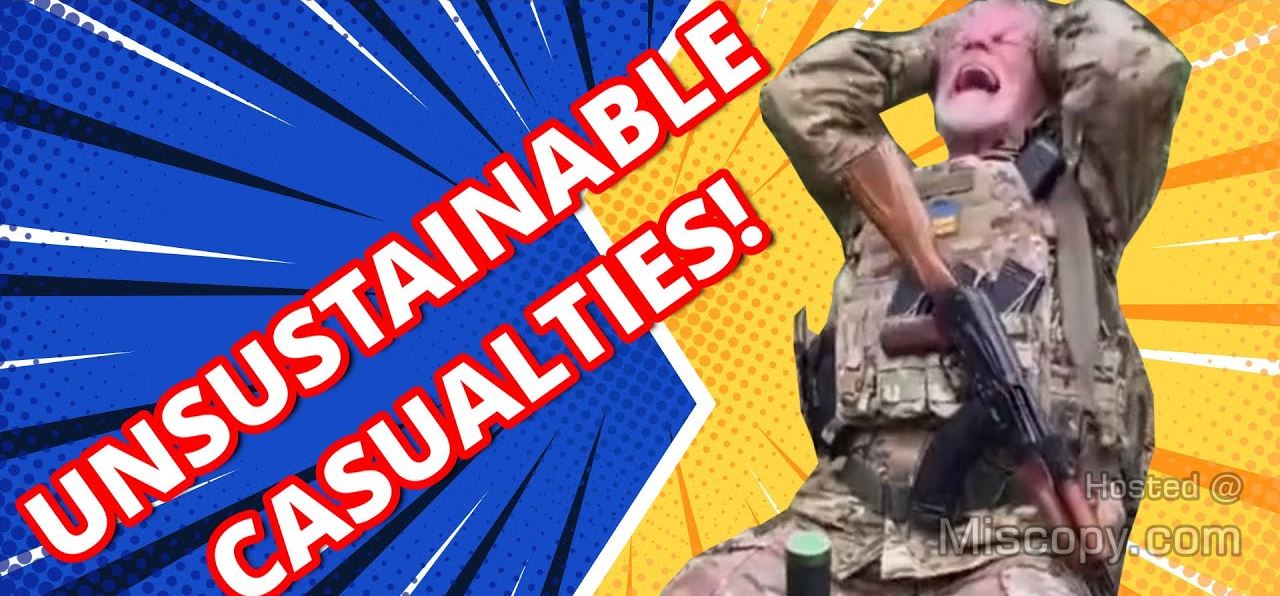00:00:00
In this section, the speaker explains why Ukraine must have higher casualties than Russia in the ongoing conflict. The speaker uses underground reports from various mainstream Western journalists and interviews with westerners who fought in the war as sources. He also highlights that Ukraine has lost the war and over 100,000 Ukrainian military officers have been killed.
Despite being outnumbered, the speaker notes that the Russians invaded with a relatively small force, and most of the soldiers were gone during the successful Ukrainian offensives. Furthermore, the speaker notes that the extreme disparity in firepower has been noted by both the Ukrainian and the Western media, and the lack of armor, artillery, and ammo on the Ukrainian side has made them less wasteful.
00:05:00
In this section, the video discusses the reasons why Ukraine must have higher casualties than Russia in the ongoing conflict. The Russian artillery, armor, and infantry are more modern and advanced than the Ukrainian forces, and the Russian air force, though limited in numbers, is still operational.
Additionally, Ukraine lacks long-range weapons, which have caused substantial damage that the media may not be reporting. The video also states that the armies’ methods of fighting differ, as Ukraine lacks armory, leading to engagements with little to no artillery support and light armored attacks without any objective. The Ukrainians are described as stubbornly holding every inch of land and engaging in sometimes-suicidal attacks with no willingness to retreat.
00:10:00
In this section of the video, the speaker discusses the lack of proper training and intelligence provided to Ukrainian soldiers on the front lines, resulting in unnecessary casualties. The mobilization process for soldiers in Ukraine is shown to be poorly managed and there have been cases of disabled individuals and even six-year-olds being called up for duty.
A firearms instructor who visited Ukraine provides a disturbing account of the conditions soldiers are facing, which is made worse by the acute manpower shortage in the country. The speaker questions the quality of troops and the losses incurred in the conflict, especially compared to the mobilized and trained Russian soldiers.
00:15:00
In this section, the speaker discusses the inefficiencies and challenges of the Ukrainian military structure, from needing approval for range time from a general to approval for gas for a car. He argues that this structure is not an effective way to fight a war, and even suggests that it may be designed to be intentionally ineffective.
Additionally, the speaker notes that the incentive to appear incompetent due to conscription has contributed to Ukraine’s lack of preparation for the war compared to Russia, which suffered major losses at the start of the conflict.
00:20:00
In this section, the speakers recount their experiences in the Ukrainian and Russian militaries. One of the speakers was saved from being part of a failed mission that caused the deaths of all of its participants.
The other speaker describes a near-death experience during his first mission. The section ends with a tragic account of a tent city that was hit by a thermobaric weapon, resulting in the deaths of 135 young officer recruits.
00:25:00
In this section, a man recounts his experience during a battle, where he thought it would be an easy win due to the close distance of the enemy. However, the opposing forces were actually much farther away and ended up causing high casualties among his team.
He describes the chaos and panic that ensued, with vehicles blowing up and people getting killed. Even though he did not fire a single round, the man was overcome with fear during the intense fight and found himself hiding in a ditch.
00:30:00
In this section, a first-hand account of a battle in Ukraine describes the overwhelming artillery fire that Russian forces employed against the Ukrainian army. Despite being outnumbered and outgunned, the Ukrainians attempted to fight back but struggled due to the Russians’ superior range advantage.
The result has been a significant disparity in casualties, with the Ukrainians sustaining upwards of 200 fatalities per day and 500 wounded while the Russians suffer fewer casualties. This strategy was a shift from earlier in the war in which the Russians engaged at closer range with Ukrainian fighters. Western volunteers also attest to the rarity of seeing Russian forces directly.
00:35:00
In this section, the speaker discusses the strategy of bombing and destroying areas before losing them to the enemy, which he claims is often done by the Russians. He also acknowledges that the casualty situation during the Ukrainian conflict turned even more in Russia’s favor.
The speaker then shares his experience of being deployed to Pisky, a contested area, with a heavily armed convoy, ready to assault the city and shovel it out. However, their convoy was spotted by drones, and their artillery missed the town, resulting in no casualties.
00:40:00
In this section, the speaker recounts his own experience of a landmine hitting their vehicle while under fire and how he lost his entire squad that day. He also highlights the Russian retreats, which were often made fun of, but which he argues were done with minimal losses and no routing.
He cites various news articles that suggest the high casualty situation of the Ukrainians, especially during the Harrison offensive and the recent fighting in the Bachman region, and highlights how even the locals are spotting for the Russian artillery.
00:45:00
In this section, the speaker discusses the reasons why Ukraine must have higher casualties than Russia in the ongoing conflict. Despite having more concentrated forces due to a manpower advantage, Ukraine holds an inferior position in armor, artillery, air force, and medium to long-range capabilities.
The lack of training, tactics, and basic supplies like winter clothing causes extreme losses reported by Ukrainian journalists and medics. The speaker refutes the two arguments that support lower Ukrainian casualties, namely the idea of attackers tripling the losses and lost equipment. The speaker emphasizes that these arguments lack logic and understanding of basic military doctrine.





Leave a Reply